|
|
 |
|
Calanoida ( Order ) |
|
|
|
Clausocalanoidea ( Superfamily ) |
|
|
|
Aetideidae ( Family ) |
|
|
|
Paracomantenna ( Genus ) |
|
|
| |
Paracomantenna wishnerae Markhaseva, 1995 (F) | |
| | | | | | | Ref.: | | | Markhaseva, 1995 (p.229, Descr.F, figs.F); Markhaseva & al., 2008 (p.2453: Rem.); Markhaseva & Renz, 2019 (p.213, p.215: Table 1). |  issued from : E.L. Markhaseva in Zoosyst. Rossica, 1995, , 1994, 3 (2). [p.229, Figs. 1-2]. Female (from 13°21.6'N, 102°28.9'W): habitus (lateral); 2, Thoracic segment 5 and urosome (lateral, left side). Nota : Cephalothorax 3.6-3.7 times as long as urosome. Rostrum absent. Points of thoracic segment 5 posterior corners exceeding posterior border of genital segment (dorsal and lateral view), directed slightly backwards (lateral view). P5 present, 2-segmented, rudimentary.
|
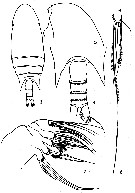 issued from : E.L. Markhaseva in Zoosyst. Rossica, 1995, , 1994, 3 (2). [p.230, Figs.3-7]. Female: 3, habitus (dorsal); 4, thoracic segment 5 and urosome (dorsal); 5, forehead (lateral); 6, right caudal ramus (dorsal); 7, Mx2. Nota : Genital segment symmetrical. 4th and 5th endites of Mx2 with 1seta spine-like and spinulose ; 1st-4th endites apically with rows of thick sclerotized foliaceous spines (typical of the genus).
|
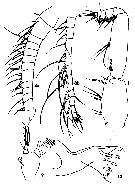 issued from : E.L. Markhaseva in Zoosyst. Rossica, 1995, , 1994, 3 (2). [p.231, Figs.8-11]. Female: 8a-b, A1; 9, Md (mandibular palp); 10, Md (gnathobase); 11, Mxp. Nota : A1 24-segmented, with long setae, shorter than cephalothorax. Md palp base with 3 setae ; endopodite 1 with 2 setae, endopodite 2 with 7 setae. Mxp protopodite without digital sensory appendage distally (as in the type species of the genus, Farran 1905), but with 4 setae, otherwise the setation typical of Aetideidae
|
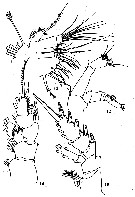 issued from : E.L. Markhaseva in Zoosyst. Rossica, 1995, , 1994, 3 (2). [p.232, Figs.12-15]. Female: 12, A2; 13, Mx1; 14, P1; 15, P2. Nota : A2 exopod shorter than endopod ; exopodite 1-4 with 1 seta each, exopodite 7 with 1 medial and 3 terminal setae. ; endopodite 1 with 2 setae, endopodite 2 with 6 terminal and 1 posterior setae at external and 8 setae at internal lobe. Mx1 gnathobase with 9 terminal spines, 1 thin terminal seta, and 1 seta on the surface of the lobe ; 2nd and 3rd internal lobes as well as protopodite near endopod base with 4 setae each ; endopod and exopod with 11 setae each, external lobe with 7 setae. Each segment of exopod of P1 with external spine, endopod external lobe well developed, with rows of fine spinules apically. Exopodite 3 of P2 with serrated margin between 1st and 2 nd and 3rd external spines.
|
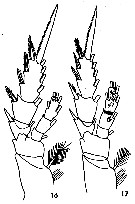 issued from : E.L. Markhaseva in Zoosyst. Rossica, 1995, , 1994, 3 (2). [p.233, Figs.16-17]. Female: 16, P3; 17, P4. Nota : Posterior surface of endopodite 2-endopodite 3 of P4 covered with thin hairs.
|
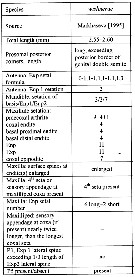 Issued from : E.L. Markhaseva & J. Renz in Arthropoda Selecta, 2019, 28 (2). [p.215, Table 1]. Selected morphological characters of P. wishnerae female. Compare with others Paracomantenna species female.
| | | | | Compl. Ref.: | | | Bradford-Grieve, 2004 (p.284). | | | | NZ: | 1 | | |
|
Distribution map of Paracomantenna wishnerae by geographical zones
|
| | | | Loc: | | | E Pacif. (off E Clipperton Is.) | | | | N: | 1 | | | | Lg.: | | | (259) F: 2,6-2,55; {F: 2,55-2,60} | | | | Rem.: | Mesopelagic (825 m), hyperbenthic.
According to Markhaseva (1995, p.233) the species is distinguished from the other species of the genus by the longer points of thoracic segment 5 posterior corners, presence of 1 seta at exopodite 1 of A2 (absent in other species), greater number of setae of Md palp, , serrated margin of P2 exopodite 3 between 1st and 2nd and 3rd external spines, and presence of a rudimentary P5. The species is similar to P. minor in the lack of the digital sensory appendage on Mxp protopodite | | | Last update : 14/02/2020 | |
|
|
 Any use of this site for a publication will be mentioned with the following reference : Any use of this site for a publication will be mentioned with the following reference :
Razouls C., Desreumaux N., Kouwenberg J. and de Bovée F., 2005-2025. - Biodiversity of Marine Planktonic Copepods (morphology, geographical distribution and biological data). Sorbonne University, CNRS. Available at http://copepodes.obs-banyuls.fr/en [Accessed January 03, 2026] © copyright 2005-2025 Sorbonne University, CNRS
|
|
 |
 |









